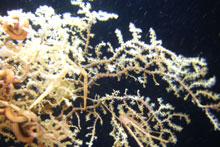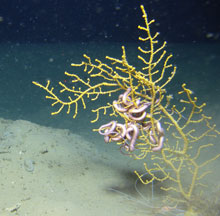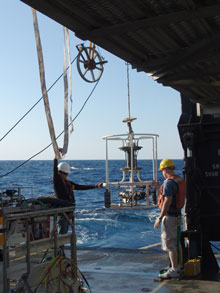The distal end (branch tips) of a gorgonian, with polyps extended, and squat lobsters and brittle stars living on the colony. Click image for larger view and image credit.
A small gorgonian with polyps retracted. The colony is attached to a small rock in soft substrate, with a brittle star on the colony and shrimp at the base. Click image for larger view and image credit.
Data at Depth
September 25, 2008
Andrea M. Quattrini
Research Associate
University of North Carolina Wilmington
Tropical coral reefs and their diverse inhabitants are familiar to people throughout the world. Less well known are the extensive coral habitats that occur on continental shelves, slopes, seamounts, and ridge systems worldwide. Corals that inhabit these environments are commonly referred to as “deep-sea” or “cold-water” corals and include numerous species of sea fans and sea whips (gorgonians), black corals (antipatharians), and hard corals (scleractinians).
Like their name implies, deep-water (or cold-water) corals are usually found in depths of 200-1,000 meters (m) (although they are known to inhabit depths up to 4,000 m) and in water temperatures of ~ 5-12 º C (~ 41-54 º F). They are also generally found in areas where there are enhanced bottom currents. Strong currents benefit coral habitat development by increasing food supply to the sessile coral polyps, by exposing hard bottom to facilitate coral polyp settlement, and by limiting sediment deposition. Too much sediment may smother coral polyps, thus inhibiting their growth.
The distribution of deep-water coral habitats in the Gulf of Mexico is likely affected by a suite of physical parameters. Besides temperature and enhanced bottom currents, other factors such as substrate type and availability, oxygen saturation, pH, salinity, current patterns, and surface productivity may control deep-sea coral habitat distribution. Long-term (diel, seasonal, and annual) data on the physical variability in these environments are lacking, yet these data are critical for understanding how these ecosystems function.
The Sea-Bird 19plus CTD being recovered from the port side of the Nancy Foster. Click image for larger view and image credit.
A conductivity-temperature-depth logger, otherwise known as a CTD, is one instrument that oceanographers use to collect physical data. The CTD measures conductivity (which can be converted to salinity), temperature, and depth of a parcel of water at a particular time interval. The CTD stores the data in its internal memory (up to 400,000 data points!) and the data are uploaded upon retrieval.
On this cruise, we are using two CTDs to collect physical data from our study sites. At every site that we sample, we are deploying a CTD from the ship to gain a profile of the water column. We also have attached a CTD to the remotely operated vehicle (ROV) to obtain physical data on the sea floor during ROV dives. We also equipped the ROV with additional sensors that can measure pH, oxygen saturation, turbidity (amount of suspended particles), and fluorescence (the amount of chlorophyll a). We have programmed the CTDs to collect all of these different kinds of data every second of every dive.
Our first two ROV dives of the cruise were successful and provided valuable biological and physical data that would have been otherwise unattainable. During the dive on September 22, we observed numerous species of gorgonians and antipatharians. They were most abundant on exposed hard substrate in depths of ~ 250-300 m. Corals were noticeably lacking on top of the feature in ~ 220 m, yet there were plenty of hard substrata all over the top of the feature.
The September 23 dive was conducted over mostly a mud bottom, with scattered patches of carbonate rubble. Even though there were available substrata at this site too, few if any corals were observed during this dive. At ~ 300-500 m, this dive was slightly deeper than the first, but well within the depth range of deep coral distribution.
Why was coral distribution patchy at these sites? Hopefully our CTD data, along with biological observations from these two dives (and future dives) will enable us to explore reasons why corals are abundant or absent in particular areas within the Gulf of Mexico. We will begin to develop hypotheses, conduct experiments, and determine the factors that shape deep-sea coral habitat distribution. Furthermore, coupling these data with long-term data from a deep coral site in the Gulf of Mexico will allow us to obtain a complete picture of these dynamic, unique ecosystems and we can begin to understand how these deep-sea communities might respond to human or environmental disturbances.
























